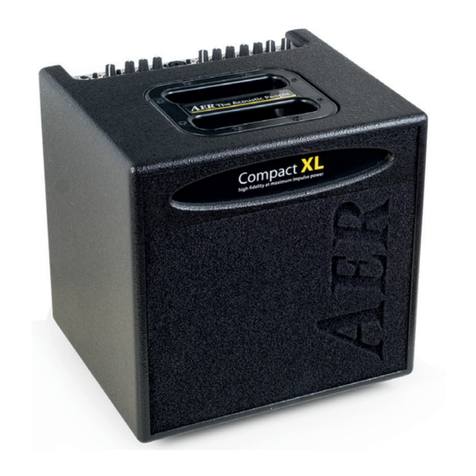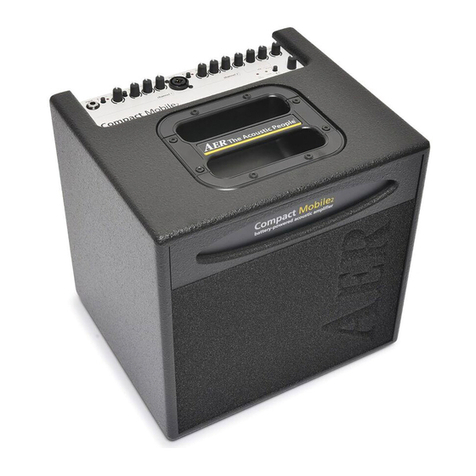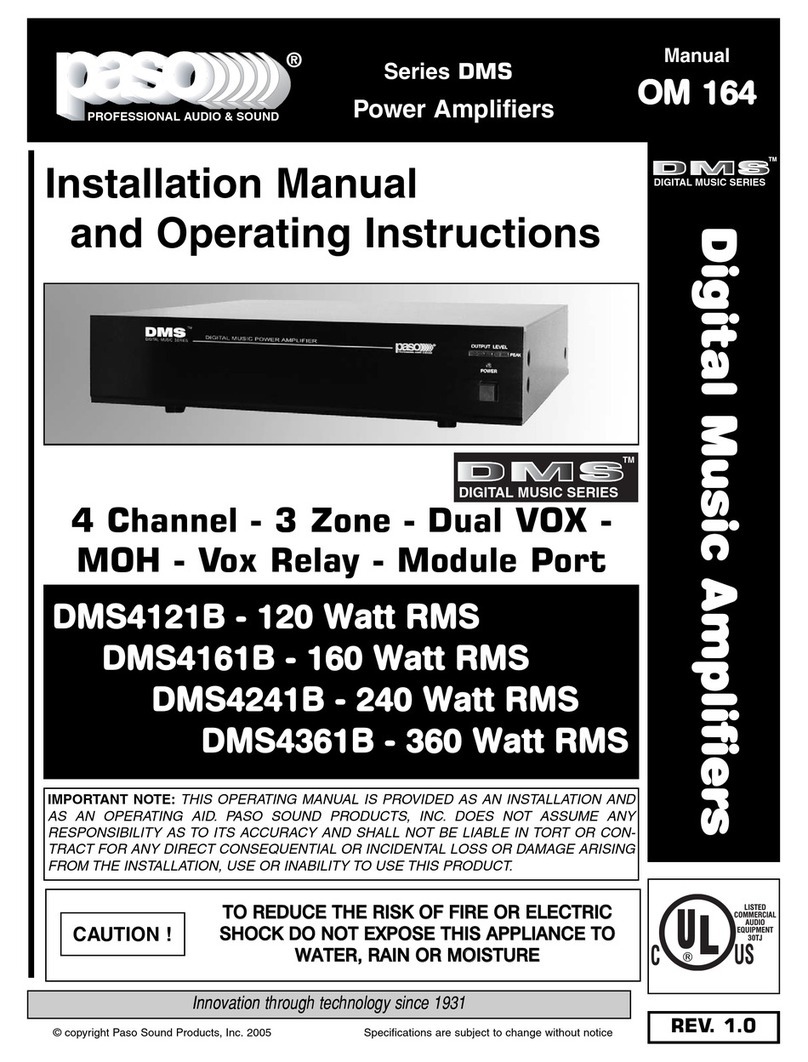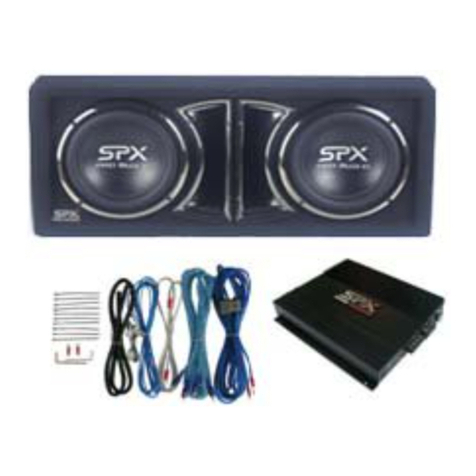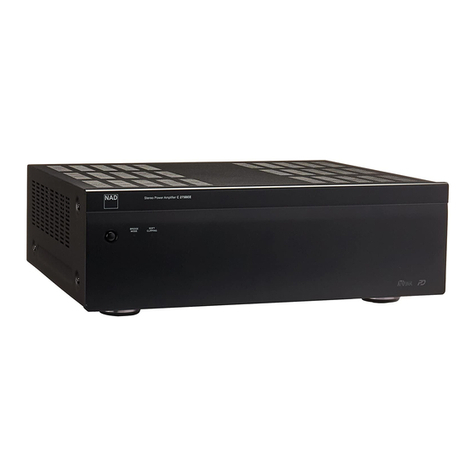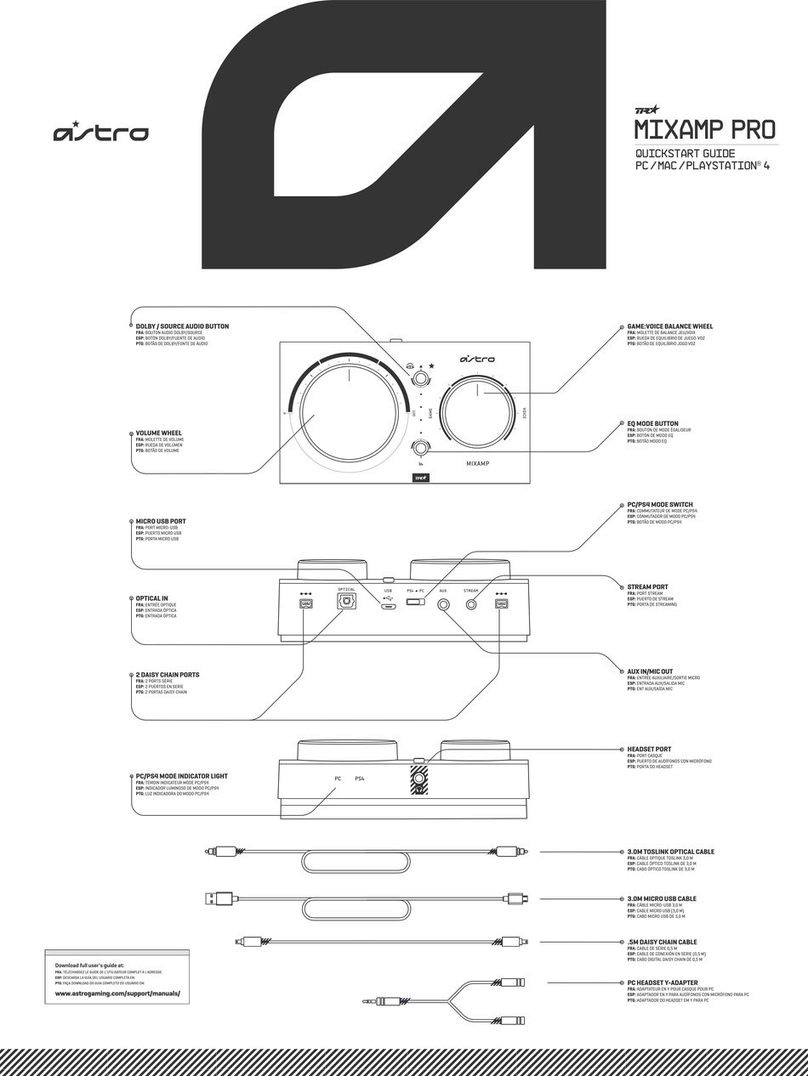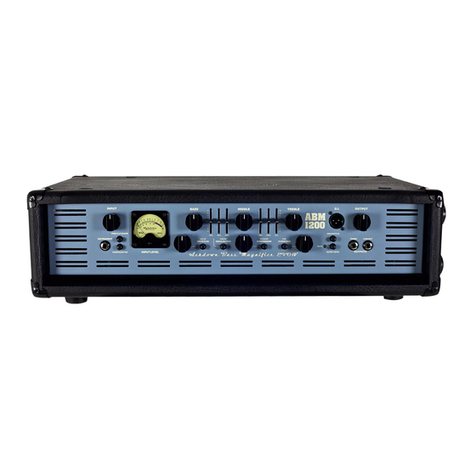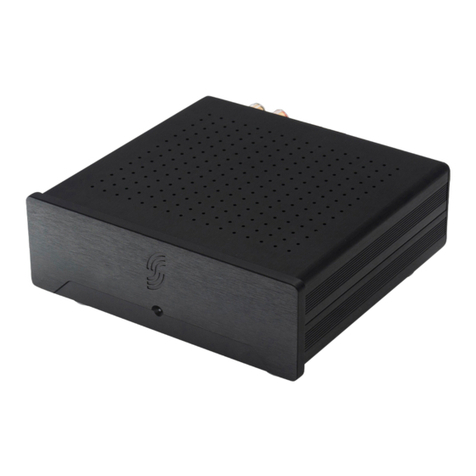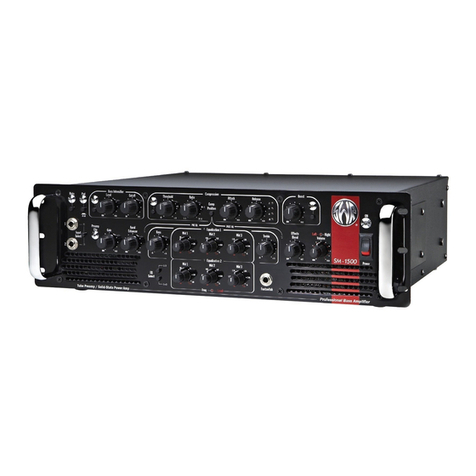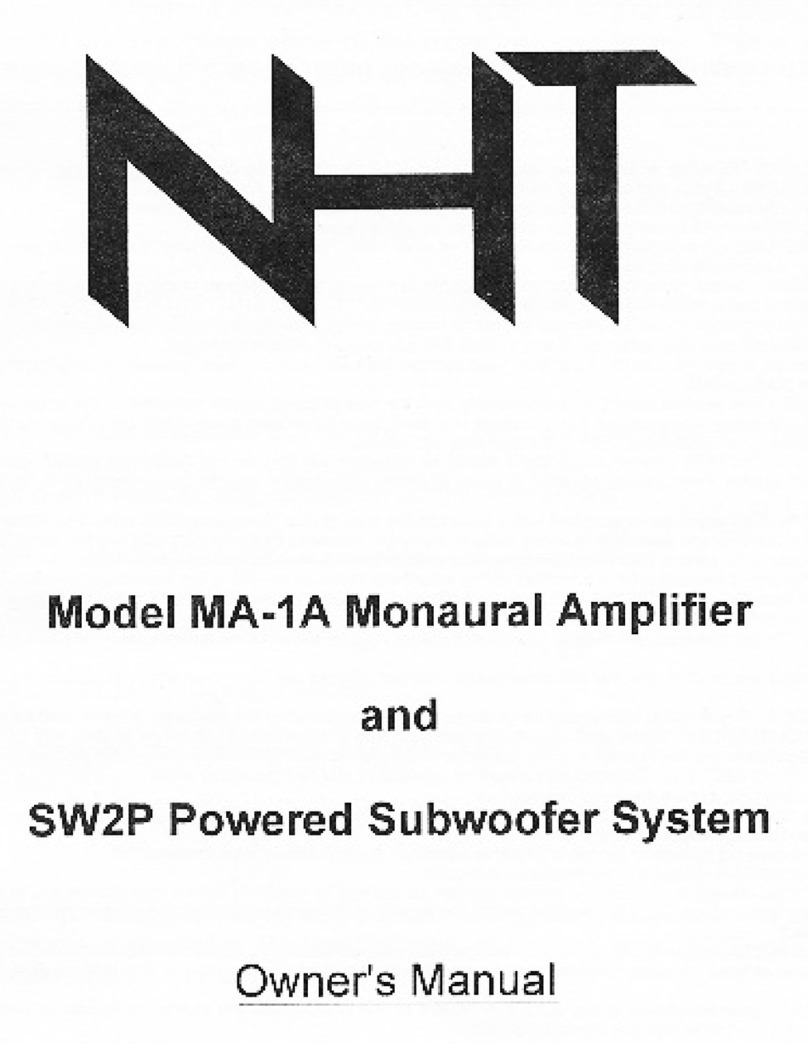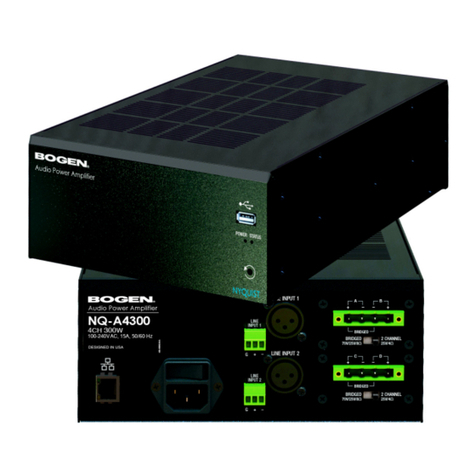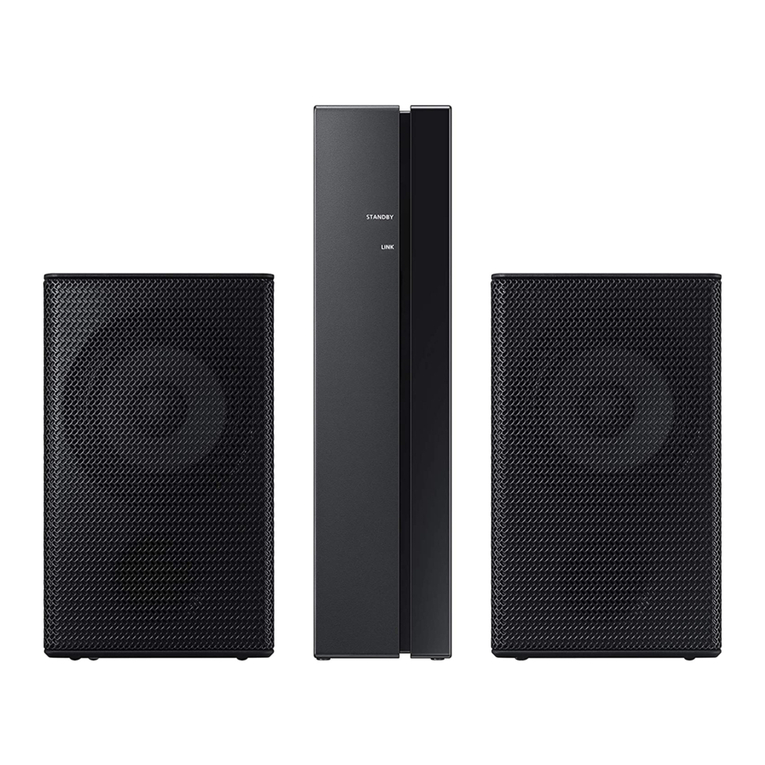AER Compact 80 pro User manual

1
Compact 80 pro
Bedienungsanleitung, User Manual , 10/2021

2
Compact 80 pro
Bedienungsanleitung
Inhalt Seite
1. Einleitung 2
2. Wichtige Sicherheitshinweise 3
3. Bedienungselemente und Anschlüsse 4
3.1 Frontseite 4
3.2 Rückseite 5
4. Inbetriebnahme 6
4.1 Anschließen und Einschalten 6
4.2 Aussteuern 6
5. Funktionsbeschreibung 6
5.1 Klangregelung 6
5.2 Eekte 7
5.3 Couple in 7
5.4 Fuß-Schalter 7
5.5 Phantomspeisung 8
6. Technische Daten 16/17
7. Blockschaltbild 18
1. Einleitung
Willkommen bei der AER. Wir freuen uns, dass Sie
sich für den Compact 80 pro entschieden haben.
Sie haben ür einen professionellen, kompakten
und leistungsstarken Akustik-Verstärker gewählt.
Alle AER-Verstärkersysteme sind dynamikkontrol-
liert, das bedeutet für Sie Zuverlässigkeit und un-
verzerrte Wiedergabe auch bei hoher Lautstärke,
und das bei verblüend kleinen Abmessungen
und geringem Gewicht.
Wir würden uns freuen, wenn der
Compact 80 pro ein wichtiges Werkzeug für
Sie wird und wünschen Ihnen viel Spaß damit.

3
2. Wichtige Sicherheitshinweise
Die folgenden Hinweise dienen der Minimierung des Verletzungsrisikos durch Feuer und Stromschlag.
1. Lesen Sie diese Sicherheitshinweise aufmerksam,
bevor Sie das Gerät benutzen.
2. Bewahren Sie diese Sicherheitshinweise sorgfältig auf.
3. Beachten Sie alle Warnungen, Anweisungen und
zusätzliche Aufschriften auf dem Gerät.
4. Dieses Gerät wurde nur für den Betrieb unter
normalen klimatischen Bedingungen (gemäßigtes
Klima) entwickelt.
5. Installieren und verwenden Sie Ihren Verstärker
nicht in der Nähe von Wasser, oder wenn Sie selbst
naß sind.
6. Setzen Sie Ihr Gerät keinen plötzlichen großen
Temperaturschwankungen aus. Dies könnte
Kondenswasserbildung im Gerät hervorrufen und
es beschädigen. Im Fall von Kondenswasserbil-
dung lassen sie bitte das Gerät vor der Benutzung
vollkommen austrocknen.
7. Betreiben Sie Ihr Gerät an einem geschützten Ort,
wo niemand auf Kabel treten oder über sie stolpern
und sie beschädigen kann.
8. Achten Sie auf eine ungehinderte Belüftung des
Verstärkers, verdecken Sie nie Belüftungsönungen
oder -gitter.
9. Ziehen Sie immer den Netzstecker, wenn Sie den
Verstärker reinigen oder für längere Zeit nicht
benutzen. Verwenden Sie für die Reinigung ein
trockenes Tuch. Vermeiden Sie den Einsatz von
Putzmitteln und achten Sie darauf, daß keine Flüs-
sigkeit in das Gerät eindringt.
10. Verwenden Sie nur passende Ersatzsicherungen
mit gleichem Nennstrom und gleicher Abschaltcha-
rakteristik. Sicherungen niemals icken! Ziehen Sie
vor dem Ersetzen einer Sicherung den Netzstecker.
Brennt eine Sicherung nach kurzer Zeit erneut
durch, muß das Gerät überprüft werden.
11. Installieren Sie Ihren Verstärker nie in der Nähe von
Geräten mit starken elektromagnetischen Feldern,
wie großen Netztransformatoren, rotierenden
Maschinen, Neonbeleuchtung etc. Verlegen Sie
Signalkabel nicht parallel zu Netzkabeln.
12. Das Innere des Geräts enthält keine durch den
Benutzer zu wartenden Teile. Um eine Gefährdung
durch Stromschlag auszuschließen, darf das Gerät
nicht geönet werden. Überlassen Sie Wartung,
Abgleich und Reparatur qualifziertem Fachpersonal.
Im Fall eines Fremdeingris erlischt die 2-jährige
Garantie.
13. Für die Einhaltung der EMV-Forderung müssen
geschirmte Kabel mit korrekt angeschlossenen
Steckverbindern für alle Signalanschlüsse verwen-
det werden.
14. Verwenden Sie immer einen geerdeten Netz-
anschluß mit der richtigen Netzspannung. Falls
Sie Zweifel haben, ob der Anschluß geerdet ist,
lassen Sie ihn durch einen qualifzierten Fachmann
überprüfen.
15. Verkabeln Sie Ihren Verstärker nur im ausgeschalte-
ten Zustand.
16. Dieses Gerät muß in der Nähe einer Netzsteck-
dose eingesetzt werden und sich leicht vom Netz
trennen lassen. Der Netzstecker muß ohne weiteres
zugänglich sein. Achten Sie darauf, daß niemand
auf das Netzkabel tritt und daß es nicht einge-
klemmt werden kann, insbesondere an Steckern,
Kabelkupplungen und an der Stelle, wo es aus dem
Gerät austritt.
17. Dieses Produkt kann bleibende Hörschäden
verursachen. Betreiben Sie es nicht für längere Zeit
mit hoher oder unangenehmer Lautstärke. Falls
Sie einen Hörverlust oder Klingeln in den Ohren
bemerken, sollten Sie einen Ohrenarzt aufsuchen.
18. Stellen Sie das Produkt nicht in der Nähe von
Wärmequellen wie Heizkörpern oder anderen
Gegenständen, die Wärme abgeben, auf.
19. Stellen Sie keine Quellen von oenem Feuer, wie
Kerzen, auf das Gerät.
20. Achten Sie darauf, daß keine Gegenstände auf das
Gerät fallen und keine Flüssigkeiten durch Önun-
gen in das Gehäuse gelangen. Stellen Sie sicher,
daß keine üssigkeitsgefüllten Gegenstände, wie
Vasen, auf das Gerät gestellt werden.
21. Stellen Sie dieses Gerät nicht auf einen
unstabilen Rollwagen, Ständer, Stativ,
Ausleger oder Tisch. Das Gerät kann
herunterfallen und ernsthafte Verletzun-
gen verursachen oder selbst beschädigt
werden.
CAUTION
RISK OF ELECTRIC SHOCK
DO NOT OPEN
ATTENTION
RISQUE DE CHOC ELECTRIQUE
NE PAS OUVRIR
Das Blitzsymbol im
gleichseitigen Dreieck
soll den Benutzer vor un-
isolierter, gefährlicher Spannung
innerhalb des Gehäuses dieses
Produkts warnen, die zu einem
elektrischen Schlag führen kann.
Das Ausrufezeichen im
gleichseitigen Dreieck
soll den Benutzer auf
wichtige Hinweise zu Betrieb und
Instandhaltung (Service) dieses
Produkts in den beiliegenden
schriftlichen Unterlagen aufmerk-
sam machen.

4
3. Bedienelemente und Anschlüsse
efx
mains & master
3.1 Frontseite
1) input (ch. 1- 4) Eingang, Kombibuchse für 6,3 mm Klinkenstecker oder XLR male
2) 9V/48 V Phantom Power Schalter o = aus, on = 9V/48 V an
3) clip Übersteuerungsanzeige
4) gain Eingangspegel-Regler
5) colour Schalter Klangfarbenlter = aus = ein
6) bass Basspegel Regler
7) middle Mittenpegel Regler
8) treble Höhenpegel Regler
9) mute Stummschaltung Anzeige
10) pan Eektsignalverteilungs-Regler
11) select Eektauswahlschalter
12) level Pegel-Regler interner Eekt
13) power led Betriebsanzeige
14) master Gesamtvolumen Regler
channels 1 - 4
channel 1 channel 2
gain bass middle treblecolour
o
on
9V / 48V
XLR=P48
XLR=P48
9V / 48V
clip
clip
gain bass treble pan select level master
clip power mute
input
input
channel 3 channel 4
gain bass middle treblecolour
colour
colour
o
on
gain bass treble pan select level
clip
input
XLR=P48
XLR=P48
input
Compact 80pro
1
2 3
4
1
2 3
4
eects
eects
6 67
3 3
8 8
4 4
1
5
1510 11 12 14
29
13

5
3.2 Rückseite
1) aux level
Pegeleinsteller für aux in
2) couple level
Pegeleinsteller für gekoppelten 2. Verstärker
3) couple in
Eingang für 2. Verstärker
4) aux in (L / R)
Aux-Eingang,
2x Mono Klinkenbuchse, 6,35 mm
5) fx send
Ausgang für einen externen, parallelen
Eektweg in Verbindung mit return
6) line out (L, R)
Vorverstärkerausgang hinter master und
Klangregelung, mit Eekten
7) DI-out (1 / 2)
Symmetrischer XLR-Ausgang
8) DI pre/post
Schaltet die Eekte (intern und extern), sowie
das Signal an aux in auf den DI-out 2
9) fx return
Eingang des externen, parallelen Eektwegs.
Auch allein als Zusatzeingang verwendbar
10) tuner
Ausgang zum Anschluß eines Stimmgeräts.
Bleibt auch bei stumm geschaltetem Verstärker
aktiv.
11) mute
Eingang für einen Fußschalter zum
Stummschalten des Verstärkers
12) headphones
Kopfhörerausgang.
Der Lautsprecher des Verstärkers wird bei
Verwendung dieser Buchse abgeschaltet
13) fx mute
Eingang für einen (Doppel) Fußschalter zum
Stummschalten der internen und externen
Eekte
14) mute
Schalter zum Stummschalten des Gerätes
aux
level
couple
level
aux in L
aux in R
couple in
fx send
line out L
DI-out
DI
pre/post
DI-out
line out R
fx return
DI-out
1 = gnd
2 = pos
3 = neg
pre fx
post fx
tuner
mute
fx mute
mute
head-
phones
tip = int. fx
ring = ext. fx
on/o
POWER
OFF
ON
Compact
80pro
multichannel acoustic amplier
ATTENTION!
SURFACE GETS HOT
8
1 2 3
10
12
11
13 14
4 5
9 6
6 7 7

6
4.2 Aussteuern
Durch richtiges Aussteuern passen Sie den
Compact 80 pro an Ihre Signalquelle an.
Lassen Sie dazu den master-Regler zunächst auf
Linksanschlag stehen
Erhöhen Sie schrittweise die betreende
gain-Einstellung gerade so weit, daß die rote
clip-Anzeige auch bei lautstarkem Spiel noch nicht
aueuchtet. Dadurch behalten Sie noch etwas
Spielraum für unerwartete Lautstärkespitzen.
Sehr starke Quellen können trotz niedriger gain-
Einstellung eine clip-Anzeige hervorrufen.
Stellen Sie zum Schluß mit dem master-Regler die
gewünschte Lautstärke ein.
• Wenn die gain-Einstellung zu niedrig ist, erreicht
der Verstärker nicht die gewünschte Lautstärke,
oder es macht sich störendes Rauschen
bemerkbar.
• Bei zu hoher Einstellung treten hörbare Verzer-
rungen (clipping) auf. Durch die clip-Leuchte
werden Sie davor rechtzeitig gewarnt.
• Wenn das Instrument einen Lautstärke-Regler
besitzt, stellen Sie diesen zum Aussteuern
anfangs auf höchste Lautstärke. Nehmen Sie ihn
aber zurück, falls die clip-Anzeige schon früh
aueuchtet und das Aussteuern schwierig ist.
• Bei nicht benutzte Kanälen stellen Sie den gain-
4. Inbetriebnahme
4.1 Anschließen und Einschalten
Vergewissern Sie sich
bitte vor dem Anschluß
an das Stromnetz, daß die
Netzspannung vor Ort
(z.B. 230 V in Europa,
120 V in den USA) mit
der zulässigen Netzspan-
nung des Gerätes übereinstimmt. Diese ist auf dem
Typenschild auf der Rückseite aufgedruckt.
Anschließen an die falsche Netzspannung kann zu
ernsthaften Schäden an Ihrem Verstärker führen!
Wenn Ihr Verstärker mit Netzspannungs-Umschalter
ausgestattet ist, ist die auf dem Umschalter ange-
zeigte Spannungsangabe maßgeblich.
Vergewissern Sie sich, daß die Phantomspeisung
(siehe 5.5) nicht unabsichtlich eingeschaltet ist.
Stellen Sie danach alle gewünschten Kabelverbin-
dungen her und schalten Sie das Gerät ein. Die
grüne power-Kontrollleuchte signalisiert Betriebs-
bereitschaft.
Regler auf Null (Linksanschlag um Störungen zu
vermeiden.
• Stellen Sie immer sicher, daß Sie volle Batterien in
Ihrem (aktiven) Pickup-System verwenden. Brum-
men und Verzerrungen können auch die Folge
einer leeren Batterie sein.
5. Funktionsbeschreibung
5.1 Mute
Der mute-Schalter auf der Rückseite des Gerätes
schaltet den Verstärker bei Bedarf stumm.
Diese Funktion kann auch über einen Fußschalter
gesteuert werden.
Bei angeschlossenem Fußschalter ist der mute-Schal-
ter nicht wirksam. Die Stummschaltung wird aber
nach wie vor durch die rote mute-LED angezeigt.
5.2 Klangregelnetzwerke
Die Klangregelung des Verstärkers ist eine hochwer-
tige Klangbeeinussung, die den natürlichen Ton
von Instrumenten und Stimme erhält und Ihnen die
Möglichkeit zur gezielten Akzentuierung bietet.
In Mittelstellung von bass, middle und treble, bei
nicht gedrücktem colour-Schalter verhält sich die
Klangregelung neutral und beeinußt den Klang
nicht.
Bereits in Neutralstellung erzeugt der Verstärker ein
sehr angenehmes, natürliches Klangbild, das Sie
mit dem colour-Filter grundsätzlich färben können.
Dabei werden die Mitten abgesenkt und die Höhen
angehoben.
Der Ton wird oener und leichter und eignet sich
besonders für Zupftechniken. Die Klangregelung
kann die Wirkung des colour-Filters unterstützen
oder mildern (siehe Abb. unten).
Hinweis: Die Klangregelung wirkt sich auch auf
die Aussteuerung aus. Falls die clip-Anzeige öfter
aueuchtet, verringern Sie mit dem gain-Regler die
Aussteuerung etwas .
Mit colour-Filter
(Schalter gedrückt)
treble absenken
um evtl. Schärfe
abzumildern.
Ohne colour-Filter
(Schalter nicht
gedrückt)
treble anheben
um den Ton
zu önen.
colour bass middle treble
colour bass middle treble

7
5.3 Eekte
Der Verstärker verfügt über zwei interne
Eektprozessoren.
Mit dem select-Schalter können Sie zwischen
4 unterschiedlichen Eekten wählen.
Für Kanal 1/2 und 3/4 sind die Eekte separat
einstellbar
1 = reverb 1 (short)
2 = reverb 2 (long)
3 = delay (320 ms)
4 = chorus
Der eects-level Regler bestimmt
die Intensität des internen Eekts
(Linksanschlag = kein Eekt).
Zusätzlich wird der Eekt durch den eects-pan-Regler
Kanal 1 und 2 oder 3 und 4 zugeteilt (siehe unten).
Externe Eekte
Darüber hinaus können zusätzliche Eektgeräte
(externe Eekte) an den Verstärker angeschlossen
werden.
Benutzen Sie dazu bitte die auf der Rückseite
bendlichen Buchsen fx send und fx return.
Der fx send wird verbunden mit dem Eingang des
externen Eekt Geräts, return wird mit dem
Ausgang des externen Eekts verbunden
return kommt vom Ausgang des externen Geräts.
Die Intensität des externen Eekts wird durch das
externe Eektgerät bestimmt.
pan
Mit dem pan-Regler können Sie den Eekt
(den internen und externen Eekt)
stufenlos den Verstärkerkanälen zumischen:
Linksanschlag: interner Eekt auf channel 1 + 2
externer Eekt auf channel 1 + 2
Mittelstellung: interner Eekt auf channel 1 + 2
externer Eekt auf channel 1 + 2
Rechtsanschlag: interner Eekt auf channel 2
externer Eekt auf channel 1
Das gleiche gilt für die Kanäle 3 und 4.
Verzerrungen im Eekt vermeiden
Eine Übersteuerung der internen oder externen Eekt-
einheit wird möglicherweise nicht durch die
clip-Kontrolleuchte angezeigt. Wenn hörbare Verzerrun-
gen im Eekt auftreten, nehmen Sie die gain-Regler zu-
rück, bis die Verzerrungen beseitigt sind. Die vorherige
Lautstärke können Sie anschließend mit dem master-
Regler wiederherstellen.
5.4 Couple in
Über den Eingang couple in können Sie den Ton eines
anderen Verstärkers in Ihrem Compact 80 pro mithören.
Verbinden Sie dazu den couple in Ihres Verstärkers
über ein XLR-Kabel mit dem DI-out des zweiten
Verstärkers. Stellen Sie dann Ihren Regler couple level
so ein, daß der zweite Verstärker in der gewünschten
Lautstärke zu hören ist.
Mit zwei Compact 80 pro funktioniert dies auch in
beiden Richtungen gleichzeitig. Sie benötigen dann
zwei XLR-Kabel. Verbinden Sie jeweils couple in mit dem
DI-out des anderen Verstärkers.
5.5 Fußschalter
An die footswitch-Buchse / -Buchsen auf der Rückseite
des Geräts kann/können Fußschalter angeschlossen
werden, mit denen Sie den Verstärker stummschalten
(mute) oder die Eekte ein/ausschalten
(fx mute) können.
Als Fußschalter eignen sich Ausführungen, die durch
einmaliges Treten eingeschaltet und durch nochmaliges
Treten wieder ausgeschaltet werden.
Für Doppel-Fußschalter benötigen Sie ein Stereo-
Klinkenkabel.
Siehe auch Bedienelemente und Anschlüsse.
Mit colour-Filter
(Schalter gedrückt)
treble absenken
um evtl. Schärfe
abzumildern.
Ohne colour-Filter
(Schalter nicht
gedrückt)
treble anheben
um den Ton
zu önen.

8
5.5. 48-V-Phantomspeisung
Mikrofone, die eine 48-V-Phantomspeisung (P 48)
erfordern, können über einen XLR-Stecker direkt
angeschlossen werden.
Die Phantomspeisung wird mit dem 9/48-V-Schalter
(Kanal 1/3) ein/ausgeschaltet.
Die 48-V-Phantomspeisung für Kanal 2 und 4 ist im
Auslieferungszustand aktiviert, kann aber durch eine
interne Steckbrücke deaktiviert werden
(Bitte beachten Sie: Für den oben genannten Eingri
muss das Gerät geönet werden. Deshalb darf die De-/
Aktivierung der Phantomspeisung nur in einer Fach-
werkstatt durchgeführt werden).
Lesen Sie dazu bitte auch die allgemeinen Hinweise zur
Phantomspeisung.
9-V-Phantomspeisung
Mit der 9-V-Phantomspeisung können entsprechend
vorbereitete Instrumenten-Vorverstärker mit Strom
versorgt werden (anstelle einer Batterie).
Solche Vorverstärker können über ein Stereo-Klinken-
kabel an input 1 oder 3 angeschlossen werden.
Die Phantomspeisung wird mit dem 9/48-V Schalter
eingeschaltet. Das Gerät erkennt automatisch welcher
Eingang (Klinke oder XLR) belegt ist und liefert 9-V oder
48-V.
Signalquellen, die keine Phantomspeisung benötigen,
sollten vorsichtshalber immer über ein Mono-Klinken-
kabel (nicht stereo) angeschlossen werden. Dadurch
wird ausgeschlossen, daß die Phantomspannung zur
Signalquelle gelangt und diese möglicherweise beschä-
digt. Achten Sie auch darauf, daß die Klinkenstecker voll
(bis zum Anschlag) eingesteckt sind.
Hinweise zur Benutzung der Phantomspeisung
Phantomspeisung bedeutet Stromversorgung
eines Audiogeräts (z.B. Mikrofon) über die
Audiokabelverbindung.
Schließen Sie an einen Eingang mit (eingeschal-
teter) Phantomspeisung nur Geräte an, die dafür
geeignet sind!
Diese Geräte sind entsprechend gekennzeichnet,
achten Sie dabei auch auf die zulässige Stromauf-
nahme (siehe tech. Daten).
Manche Geräte benötigen zwar keine Phantom-
speisung, können aber damit 'leben'.
Bei anderen Geräten, die nicht ausdrücklich für
den Betrieb mit Phantomspeisung entwickelt
wurden, können erhebliche Störungen und auch
Schäden auftreten.
Bei Unsicherheit erkundigen Sie sich bitte beim
Hersteller des von Ihnen verwendeten Geräts!

9
1. Introduction
Welcome to AER!
Thank you for choosing the Compact 80 pro.
You have chosen a professional, compact and powerful
acoustic amplier.
All AER amplier systems are dynamically controlled,
which ensures reliability and low distortion playback
even at high volume despite strikingly the small size
and light weight.
We would be happy if the Compact 80 pro
would be an important tool for you.
We wish you a lot of fun with it.
Read on and have fun using your Compact 80 pro
Compact 80 pro
User Manual
Content Page
1. Introduction 10
2. Important Safety Instructions 11
3. Controls and connections 12
3.1 Front side 12
3.2 Rear side 11
4. Starting up 12
4.1 Cabling and switching on 12
4.2 Level adjustment 13
5. Functional characteristics 14
5.1 mute 14
5.2 Tone control 14
5.3 Eects 15
5.4. Couple in 15
5.5 Footswitch 15
5.6 Phantom powering 16
6. Technical specs 16/17
7. Block diagram 18

10
2. Important Safety Instructions
The following guidelines shall help minimize the risk of injury through re or electric shock.
1. Carefully read these safety notes before you use the
device!
2. Keep these safety notes in a safe place.
3. Pay attention to all warnings, instructions and additi-
onal texts on the unit.
4. This device was only designed for operation under
normal climatic conditions (temperate climate).
5. Do not install or use your amp in close proximity to
water or if you are wet yourself.
6. Do not subject your device to sudden and severe
temperature changes. This could cause moisture
condensation inside the unit, which could damage
it. In the event of moisture condensation allow the
device to dry out completely before use.
7. Use your amp in a safe place where nobody can step
on cables or trip over and damage them.
8. Pay attention to an unhindered air circulation
around the amp, never obstruct the air vents or grilles.
9. Always pull the mains plug before cleaning your
amp or when left unused for a long period of time.
Use only a dry cloth for cleaning. Avoid the use of
detergents and do not let any liquids seep into the
unit.
10. Use only the right fuses with the same current
rating and trigger characteristic as replacements. Ne-
ver mend fuses! Pull the mains plug before replacing
a fuse. Should a fuse blow again after a short while,
the device needs to be checked.
11. Never install your amp close to devices with strong
electromagnetic elds such as large mains transfor-
mers, revolving machines, neon illumination etc. Do
not lay signal cables parallel to power current cables.
12. There are no user-serviceable components inside the
unit. To avoid the risk of an electric shock, the unit
must not be opened. All maintenance, adjustment
and repair works should be carried out by qualied
sta only. Any unauthorized tampering will void the
2-year warranty.
13. In keeping with the EMV regulations screened cables
with correctly tted connectors must be used for all
signal connections.
14. Always use an earthed power supply with the
correct mains voltage. If you are in doubt about the
power outlet ground, have it checked by a qualied
technician.
15. Cable up your amp only when it is powered o.
16. This device should be installed near the socket out-
let and disconnection of the device should be easily
accessible. The mains plug of the power
supply shall remain readily operable. Protect the
power cord from being walked on or pinched par-
ticularly at plugs, convenience receptacles and the
point where they exit from the apparatus.
17. This product may cause permanent hearing loss.
Do not operate for long periods of time at a high
volume level or at any level that is uncomfortable.
If you experience any hearing loss or ringing in the
ears, you should consult an audiologist.
18. The product should be located away from heat
sources such as radiators, heat registers or other
products that produce heat.
19. Do not place any open sources of re, like candles,
on the device.
20. Care should be taken so that objects do not fall onto
the device and liquids are not spilled into the enclo-
sure through openings. Ensure that no objects lled
with liquids, such as vases, are placed on the device.
21. Do not place this device on an unstable cart, stand,
tripod, bracket or table. The device may fall, causing
serious injury to you and serious damage
to the device itself.
CAUTION
RISK OF ELECTRIC SHOCK
DO NOT OPEN
ATTENTION
RISQUE DE CHOC ELECTRIQUE
NE PAS OUVRIR
The lightning ash with
the arrow head symbol
within an equilateral
triangle is intended to alert the
user to the presence of unisolated
´dangerous voltage´ within this
product´s enclosure that may
be of sucient magnitude to
constitute a risk of electric shock
to persons.
The exclamation point
within an equilateral
triangle is intended to
alert the user to the presence
of important operating and
maintenance (servicing)
instructions in the literature
accompanying this product.

11
3. Controls and connections
efx
mains & master
channels 1 - 4
3.1 Frontside
1) input (ch. 1+- 4) inputs, combo socket for 1/4" (6,35 mm) jack or XLR male
2) 9V/48 V phantom-power switch o , on = 9V/48 V
3) clip overload indicator
4) gain input level control
5) colour switch for tone colour = o = on
6) bass bass tone control
7) middle middle tone control
8) treble treble tone control
9) mute channel mute indicator
10) pan eect distribution control
11) select eect select switch
12) level level control internal eect
13) power led on/o status indicator
14) master master level control (volume)
channel 1 channel 2
gain bass middle treblecolour
o
on
9V / 48V
XLR=P48
XLR=P48
9V / 48V
clip
clip
gain bass treble pan select level master
clip power mute
input
input
channel 3 channel 4
gain bass middle treblecolour
colour
colour
o
on
gain bass treble pan select level
clip
input
XLR=P48
XLR=P48
input
Compact 80pro
1
2 3
4
1
2 3
4
eects
eects
6 67
3 3
8 8
4 4
1
5
1510 11 12 14
29
13

12
3.2 Rear side
1) aux level
level control for aux in
2) couple level
level control for coupled 2nd amplier
3) couple in
input for 2. amplier
4) aux in (L / R)
aux-in input, 2x mono jack socket, 6,35 mm
5) fx send
output for an external, parallel eect loop
in conjunction with return.
6) line out (L, R)
Preamplier output post master and tone
controls, with eects
7) DI-out (1 / 2)
balanced XLR-output, pre master
8) DI pre/post
Switches the eects (internal and external) as
well as the signal at aux in on DI-out 2
9) fx return
Input of the external, parallel eect loop
(see also fx send).
Can also be used alone as additional input.
10) tuner
Output, pre master, for a tuner.
Remains active when the amp is muted.
11) mute
footswitch input to mute the amp
12) headphones
Output for headphones. The loudspeaker of
the amplier is switched o when this socket is
used.
13) fx mute
input for a (double) footswitch to mute internal
and external eects
14) mute
switch for muting the amp
aux
level
couple
level
aux in L
aux in R
couple in
fx send
line out L
DI-out
DI
pre/post
DI-out
line out R
fx return
DI-out
1 = gnd
2 = pos
3 = neg
pre fx
post fx
tuner
mute
fx mute
mute
head-
phones
tip = int. fx
ring = ext. fx
on/o
POWER
OFF
ON
Compact
80pro
multichannel acoustic amplier
ATTENTION!
SURFACE GETS HOT
8
1 2 3
10
12
11
13 14
4 5
9 6
6 7 7

13
4.2 Level adjustment
By proper level adjustment you adapt your
Compact 80 pro to your signal source.
For this purpose keep the master control initially
fully anticlockwise.
Gradually increase the appropriate gain setting as far
as possible but without triggering the red clip indica-
tor, even when you play loud. Thereby you keep some
headroom for unexpected peak levels.
Very strong sources may cause a clipping warning
despite a low gain setting.
Finally set the desired volume using the master
control.
• If the gain setting is too low, the amplier may
not reach the desired volume, or distracting noise
may become noticeable.
• Setting the gain too high causes distorted sound
(clipping). The clip light will warn you before this
happens.
• If you use an instrument with a volume control,
start o with full volume but reduce it if the clip
indicator lights up early and the level adjustment
is dicult.
• Please ensure there is always enough battery
power in your (active) pick-up system. Humming
and sizzling may be caused by an empty battery.
4. Starting up
4.1 Cabling and switching on
Before connecting to mains, please ensure that your
local mains voltage
(e.g. 120V in the
USA, 230V in Europe)
matches the voltage
rating of the device,
which is printed on
the type label on the rear side of the unit.
Connecting to the wrong mains voltage may cause
serious damage to your amplier!
Make sure the phantom power is not switched on
unintentionally.
Then connect all cables according to your applica-
tion and switch the device on. The green power LED
indicates operational readiness.
• If several inputs are used simultaneously, you also
determine the mixing ratio by the individual gain
settings.
• The gain controls of any unused inputs should stay
fully anticlockwise.
5. Functional characteristics
5.1 Mute
The mute switch on the rear side turns the amplier to
mute as required.
This function can also be controlled by a footswitch.
When the footswitch is connected, the mute switch is
not in eect, but the muted state is still indicated by
the red mute LED.
5. 2 Tone controls
The tone controls of the amplier are a high-quality
sound modication tool that preserves the natural
tone of instruments and voice and allows you to apply
targeted accentuations.
If bass, middle, and treble are in center position,
the colour switch is not pushed, the tone controls are
neutral and have no inuence on the sound.
The amplier will already provide a very pleasant,
natural sound when all controls are in neutral position,
which you can then principally alter with the colour
lter (in channel 1). This will reduce the midrange
and bring out the trebles. The sound becomes more
open and lighter and is particularly suitable for nger
picking techniques. The tone controls can support or
attenuate the eect of the colour lter (see illustration
below).
Please note:
The tone controls have an eect on the signal level. If the
clip indicator ashes more frequently, reduce the level a bit
using the gain control (see also 4.2).
Without colour-lter
(switch not pressed)
boost treble to
brighten the sound
With colour-lter
(switched pressed)
reduce treble
to soften possible
harshness
colour bass middle treble
colour bass middle treble

14
5.3 Eects
Internal Eects
The Compact 80 pro has two built-in (internal) digital
eect processors. With the select switch you can
choose between 4 dierent eects.
1 = reverb 1 (short)
2 = reverb 2 (long)
3 = delay (320 ms)
4 = chorus
You can control the eects separately for ch. 1/2 and 3/4.
The eects-level control determines the intensity
of the eect.
(fully anticlockwise = no eect).
In addition, the eect is assigned to channels 1 and 2 or
channels 3 and 4 by the eects pan control (see below).
External Eects
Furthermore an additional eect unit (external eect)
may be connected to the amplier. For this purpose use
the send and return sockets on the rear side of the amp-
lier (send is connected to the input, return is connected
to the output of the external device).
The intensity of the eect is determined by the external
eects unit.
The external eect loop works in parallel mode.
A parallel loop is intended to add the eect component
(for example, reverb) to the original signal.
pan
Using the eects pan control you can blend both eects
continuously into the amplier's channels:
Left stop: internal eect on channel 1
external eect on channel 2
Center pos.: internal eect on channel 1 + 2
external eects on channel 1 + 2
Right stop: internal eect on channel 2
external eect on channel 1
(The same goes for channels 3 and 4)
Avoid distorted eects
Clipping in the internal or external eect unit may not be
indicated by the clip light. If distortion is audible in the
eect, reduce the gain controls until the distortion disap-
pears. Subsequently you can restore the previous volume
with the master control.
5.4 Couple in
You can monitor the sound of another amplier via the
couple-in input.
Connect your amplier using the couple-in jack with an
XLR cable to the DI-out of the second amplier.
Adjust the couple level control so that the second
amplier can be monitored at the desired volume on
your amp.
With two Compact 80 pro this works in both directions
at the same time.
You need 2 XLR cables.
Connect each couple in to the DI-out of the other
amplier.
5.5 Footswitch
The footswitch sockets at the back of the device can
be used to connect footswitches for muting (mute) or
turning on/o the eects (fx mute).
Dual footswitches require a stereo jack lead. See also
'controls and connections'.
Suitable footswitches are on-o toggle switches, which
are turned on by stepping once, and turned o by step-
ping once again.

15
5.6. Phantom-power
48 V phantom power at microphone input
Microphones that require 48 V phantom power
(P 48) can be connected directly by an XLR plug.
The 48 V phantom power is switched by the 9 V/48 V
switch in ch. 1/3.
For channels 2/4 the amplier is supplied with the
phantom power enabled, but it can be disabled by an
internal jumper. (see note)
Please also read the general notes on
phantom power.
Please note: For the alteration mentioned above, the
device must be opened, therefore only qualied per-
sonnel may carry out the de-/activation of the phantom
power.
9 V phantom power at line input
The 9 V phantom power supplies instrument preamps
with power (instead of a battery) that are prepared ac-
cordingly. Such preamps are connected to input 1and 3
by a stereo jack cable.
The phantom power can be switched on by the 9 V/48
V switch. The amplier supplies either 9V or 48 V depen-
ding on the kind of plug being used.
Sources that don't need phantom power should always
be connected via a mono jack cable (not stereo) as a
precaution. This way the phantom power cannot get to
the source and possibly damage it.
Also make sure that the plugs are fully plugged in.
Notes on the use of phantom power
Phantom power means remote power supply of an
audio device (e.g. microphone) via the audio line.
Only suitable devices should be connected to an
input with (activated) phantom power.
Such devices are also marked accordingly. Please
heed the permissible power consumption (see
technical data).
Some devices do not need phantom power
but tolerate it.
Other devices that have not been designed expli-
citly for phantom power operation can suer from
considerable malfunction and damage may result
as well.
In case of uncertainty please consult the
manufacturer of your accessories.

16
6. Technical specications
Inputs
channels 1-4 Instrument / line / microphone input
Connector: Combo (jack and XLR)
Instrument / Line input (6.35 mm jack)
High impedance unbalanced input, for
instrument pickups or as universal line input
Connector: ¼”(6.35 mm) stereo* jack
*Ch. 1 and ch. 3 have phantom power which uses
the ring of the stereo jack.
Nom. input voltage: 100 mV (–20 dBV)
Min. input voltage: 20 mV (–34 dBV)
Max. input voltage: 5 V (+14 dBV)
Input impedance: 2.2 MΩ || 300 pF
Signal / noise ratio (A-weighted): 88 dB
Equivalent input noise voltage (A-weighted):
4 µV (-108 dBV)
Phantom power (ch. 1 / 3 only): 9 V DC
Load current (per channel): max. 20 mA
Switchable
Short circuit protected
Microphone input (XLR)
Balanced input for microphones
Connector: XLR female
1 = ground
2 = positive (+)
3 = negative (–)
Nom. input voltage: 10 mV (- 40 dBV)
Min. input voltage: 4 mV (- 48 dBV)
Max. input voltage: 1 V (0 dBV)
Nom. source impedance: 200 Ω
Input impedance: 1.2 kΩ
Voice lter (referred to 10 kHz): -10 dB at 270 Hz
Signal / noise ratio (A-weighted): 80 dB
Equivalent input noise voltage
(A-weighted): 1 µV (-120 dBV)
Phantom power: 48 V DC
Supply resistors: 6.8 kΩ
Load current (per channel): max. 10 mA
Switchable in ch. 1 and 3
Permanent in ch. 2 and 4
clip indicator
Indicates imminent distortion in input channel
Headroom approx. 5 dB
aux in L/R Auxiliary stereo input with level control
Connector: dual ¼”(6.35 mm) mono jack
Nom. input voltage: 500 mV (–6 dBV)
Min. input voltage,
using one input: 200 mV (–14 dBV)
using both inputs: 100 mV (–20 dBV)
Max. input voltage: 4.5 V (+13 dBV)
Input impedance: 22 kΩ
couple in Balanced input with level control for connecting
to DI-out of another amplier
Connector: XLR female
1 = ground
2 = positive (+)
3 = negative (–)
Nom. input voltage: 40 mV (–28 dBV)
Min. input voltage: 20 mV (–34 dBV)
Max. input voltage: 6 V (+16 dBV)
fx return Input for external parallel eect loop, also useful
as an extra line input
Connector: ¼” (6.35 mm) mono jack
Nom. input voltage: 330 mV (–10 dBV)
Input impedance: 20 kΩ
Outputs
line out L/R Preamplier output post master, tone controls,
aux in, and eects
Connector: dual ¼”(6.35 mm) mono jack
Nom. output voltage: 1 V (0 dBV)
Output impedance: 47 Ω
Min. load impedance: 2 kΩ
Residual noise (A-weighted): 4 µV (–108 dBV)
headphones output
Connector: ¼”(6.35 mm) stereo jack
Output power for dierent headphone
impedances:
8 Ω 2 mW
32 Ω 10 mW
2000 Ω 70 mW
Nom. output voltage, no load: 18 V
Output impedance: 1000 Ω
Residual noise (A-weighted), referred to rated
output power: –99 dB
When plugged in, the speaker is muted.
fx send Output for external parallel eect loop (post tone
controls, but pre aux)
Connector: ¼” (6.35 mm) mono jack
Nom. output voltage: 300 mV (–10 dBV)
Output impedance: 47 Ω
Min. load impedance: 2 kΩ
tuner Tuner output (post tone controls, but pre aux
and eects)
Connector: ¼”( 6.35 mm) mono jack
Nom. output voltage: 100 mV (–20 dBV)
Output impedance: 47 Ω
Min. load impedance: 2 kΩ
DI-out Electronically balanced, non-isolated output
(post tone controls, but pre aux and eects)
Connector: XLR male
1 = ground
2 = positive (+)
3 = negative (–)
Nom. output voltage: 40 mV (–28 dBV)
Output impedance: 2 x 47 Ω
Min. load impedance: 1 kΩ
DI-out 2 Same as DI-out, but switchable pre / post aux
and eects
Footswitch connectors
mute Single footswitch for master mute
Connector: ¼” (6.35 mm) mono jack
Function: Switch ON = amp muted
fx mute Dual footswitch for int./ext. eects mute
Connector: ¼” (6.35 mm) mono jack
Tip = switch for internal eect
Ring = switch for external eect
Sleeve = common return (ground)
Function: switch ON = eect OFF

17
6. Technical specications
Tone controls (each channel)
color Switchable lter
at 700 Hz –3 dB
at 8 kHz +10 dB
Only for ch. 1 and 3:
Bass (100 Hz) ±8 dB
Middle (800 Hz) ±6 dB
Treble (10 kHz) ±8 dB
Only for ch. 2 and 4:
Bass (100 Hz) ±8 dB
Treble (10 kHz) ±11 dB
Eects
Internal efx Two independent digital eects for
ch. 1-2 and ch. 3-4.
Presets for each unit:
1. reverb
2. reverb with longer predelay
3. delay, repetitive (320 ms)
4. chorus
External efx Parallel eect loop, see fx send and fx return
eects pan Blends eect between ch. 1 and 2, or ch. 3 and 4
respectively. The direction of rotation is reverse
for the external eect.
Power amp
Construction Two monolithic ICs with DMOS output in
parallel mode
Rating Output power (THD = 1%) 80 W / 4 Ω
Continuous output power is determined by the
limiter threshold, see below.
General
Distortion THD + N (8 W / 4 Ω) < 0.1%
Measured at loudspeaker terminals
Noise Residual noise (A-weighted, master in zero
position), referred to rated output power:–99 dB
Acoustical (SPL): approx. 13 dB (A) / 1 m
See input specs for noise of specic inputs.
Signal processing
Subsonic lter, adaptive peak limiter
Limiter
Threshold: 65 W / 4 Ω
Speaker system
8”(200 mm) dual cone full-range speaker,
bass reex enclosure
Power supply
Mains voltage (depending on model, refer to
type label): 100, 120, 230, or 240 V~, 50–60 Hz
Power consumption: max. 140 W
Mains fuse Size: 5 x 20 mm
Rating (refer to type label)
for 230, 240 V models: T 1.6A L 250V
for 100, 120 V models: T 3.15 A L 250V
Operating temperature
Permissible ambient temperature 0…35 °C
Cooling fan Temperature controlled
Cabinet
Material: Birch plywood
Thickness: 12 mm (0.39”)
Finish: waterbased acrylic, black spatter nish
Dimensions and weight
Height: 320 mm (12.6”)
Width: 325 mm (12.8”)
Depth: 285 mm (11.22”)
Weight (without cover): 10 kg (22 lbs)
Notes
Options Congurable by internal jumpers (refer modication to
qualied personnel):
• Deactivation of 48 V phantom power for ch. 2 and ch. 4,
mic input
Denitions
Rated conditions
• nominal input voltage at input under test
• master fully clockwise
• bass / middle / treble / pan centered
• eects level fully anticlockwise
• gain of unused inputs fully anticlockwise
• gain of input under test adjusted to nominal output voltage
at line out.
Nominal input voltage:
Condition for specications, if not stated otherwise.
Minimum input voltage
Input voltage required for nominal output ratings with
maximum gain and volume settings.
Maximum input voltage
Input voltage that does not cause distortion more than rated
THD+N, suitable control settings provided.
Nominal output voltage or power
refer to rated conditions.
THD + N
Total harmonic distortion + noise, with input voltage reduced by
10 dB after setting up rated conditions.
Signal / noise ratio
Ratio of nominal output voltage to output noise voltage. Source
voltage reduced to zero after setting up rated conditions.
Equivalent input noise voltage
Noise voltage at output terminals divided by gain of amplier.
Source voltage reduced to zero after setting up rated conditions.
Residual noise
Output noise with minimal gain and volume settings.
Adaptive limiter
Maintains constant headroom regardless of power supply
uctuations.
General
Signal voltages are RMS values. Test signal sine 1 kHz sine unless
stated otherwise. Noise measured from 20 Hz to 20 kHz. Noise
stated for a specic input implies that all other inputs are not
used. Sound pressure level (SPL) based on specication by
loudspeaker manufacturer.
Specications and appearance subject to change without notice.
TD20210421_en (Compact 80 pro)

18
B191216C-20201203
CLIP DETECTION
CLIP DETECTION
MIDDLE
SUBSONIC LIMITER POWER AMP
FX CH 1/2
DUAL CONE SPEAKER
TUNER
TREBLEBASS
SEND
FX LEVEL
MASTER
LINE OUT R
FOOTSWITCH FX
RETURN
1k
DI-out 2
GAIN
PREAMP VOICE
6k8
6k8
MIC
LINE
FX PAN
CH1
CH2
PREAMP
MIC GAIN H/L
FX SELECT
CLIP DETECTION
+48V
CLIP
CLIP DETECTION
DI out pre/post FX/Aux
HEADPHONES
1k
AUX LEVEL
+9V
TREBLEBASS
GAIN
CLIP DETECTION
CLIP
CLIP DETECTION
COUPLE IN
PREAMP
FX CH 3/4
FX LEVEL
FX PAN
CH3
CH4
FX SELECT
COUPLE LEVEL
LINE OUT L
DI-out
FOOTSWITCH MUTE
Standby / Mute
MUTE
AUX IN L
AUX IN R
FX PAN
CH1
CH2
FX PAN
CH3
CH4
COLOUR
COLOUR
PHANTOM POWER
COLOUR
COLOUR
PREAMP VOICE
6k8
6k8
MIC
LINE
PREAMP
+48V
CLIP DETECTION
MIC GAIN H/L
CLIP DETECTION
CW
CH. 1
CH. 2
CH. 3
CH. 4
Same as ch. 1
Same as ch. 2
CW CWCW
T R
1
2
3
1
2
3
TR
SRT
1
2
3
1
2
3
1
2
3
TR
7. Block diagram

19

20
Sales
Africa, America, Asia, Oceania
aer music gmbh
Haberstrasse 46
D-42551 Velbert
info@aer-music.de
aer amplier gmbh
Haberstrasse 46
D-42551 Velbert
info@aer-amplier.de
Sales
Europe
www.aer-music.de
Table of contents
Languages:
Other AER Amplifier manuals
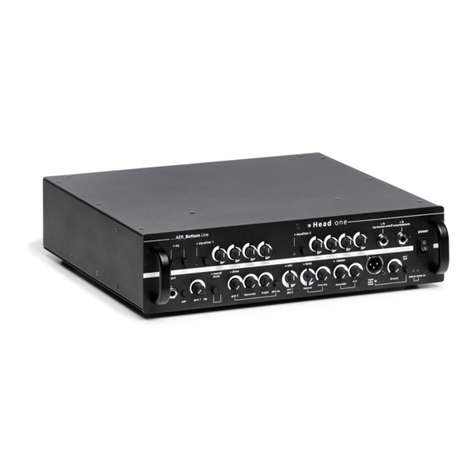
AER
AER HEAD ONE User manual

AER
AER pocket tools dual mix User manual
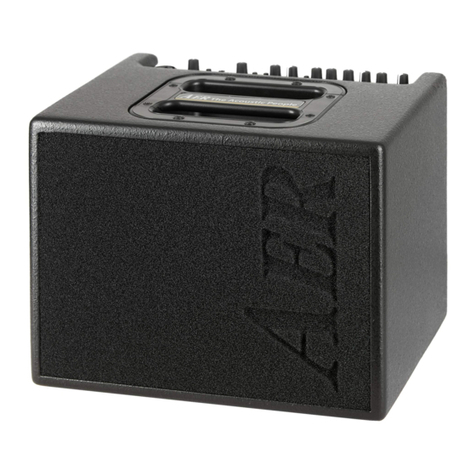
AER
AER Compact Classic pro User manual
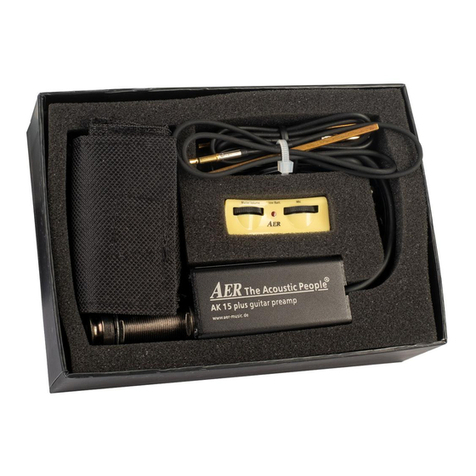
AER
AER AK15 plus User manual
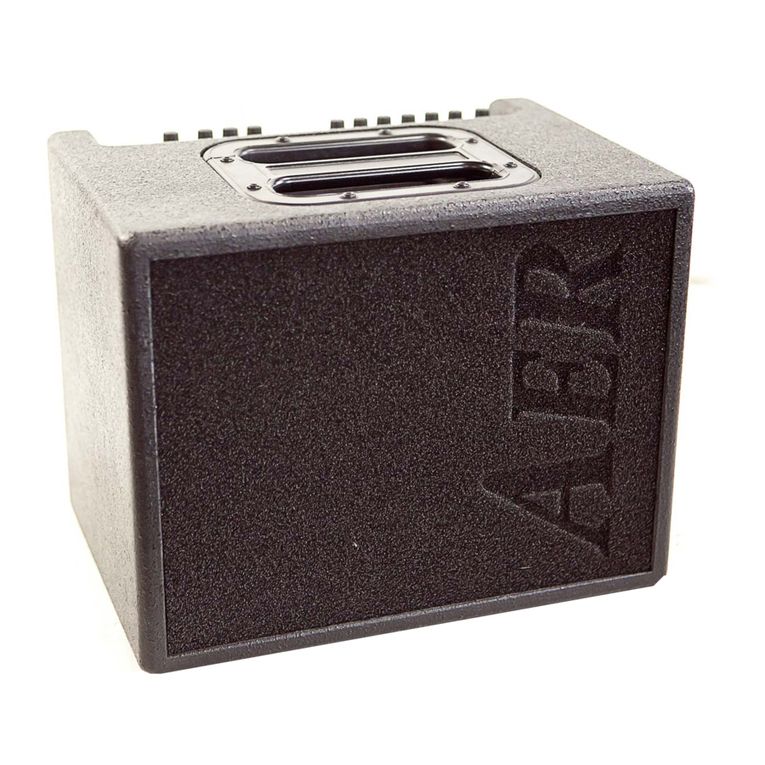
AER
AER COMPACT 60 2 User manual

AER
AER acoustiCube 3 User manual
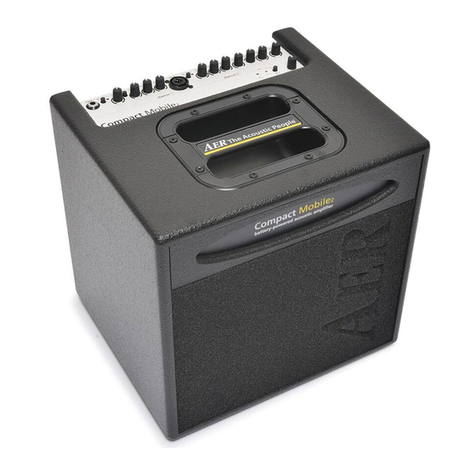
AER
AER COMPACT MOBILE 2 User manual

AER
AER The Acoustic People pocket tools colourizer User manual

AER
AER The Acoustic People Compact 604 User manual
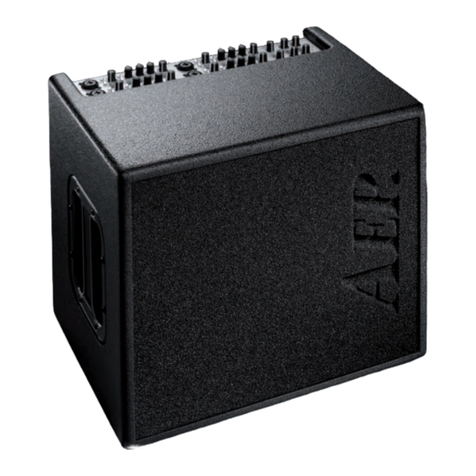
AER
AER domino 3 User manual
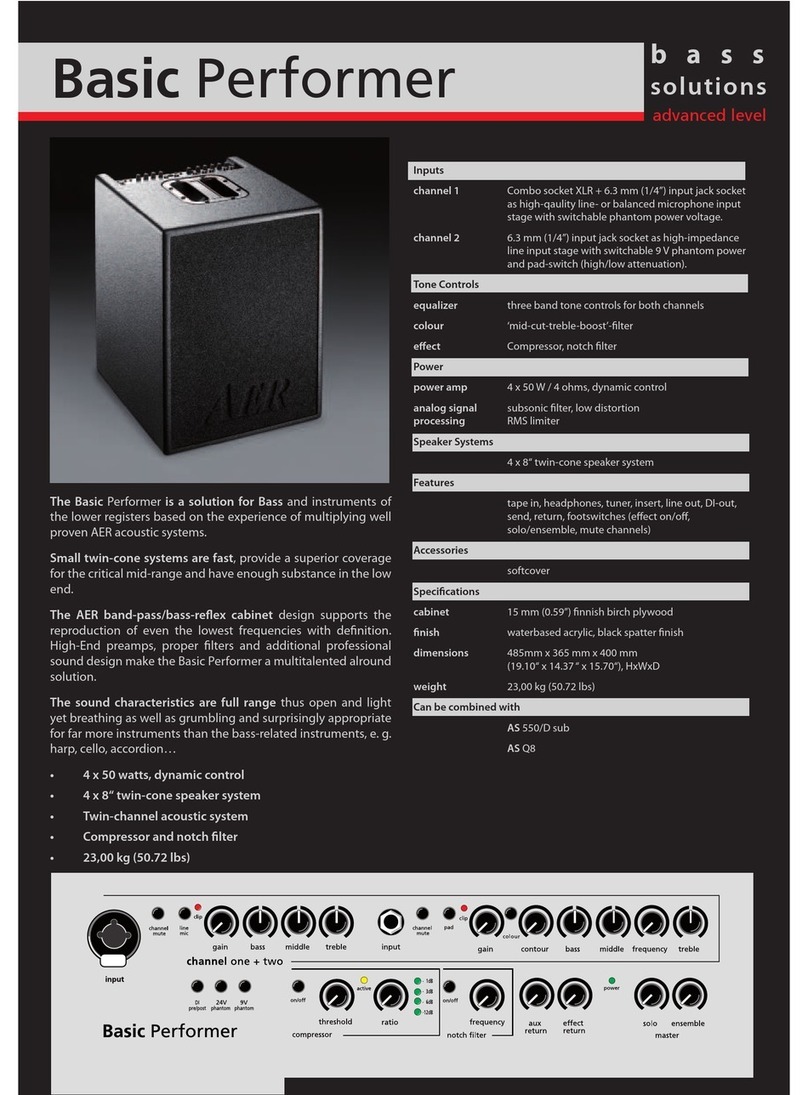
AER
AER Basic Performer User manual
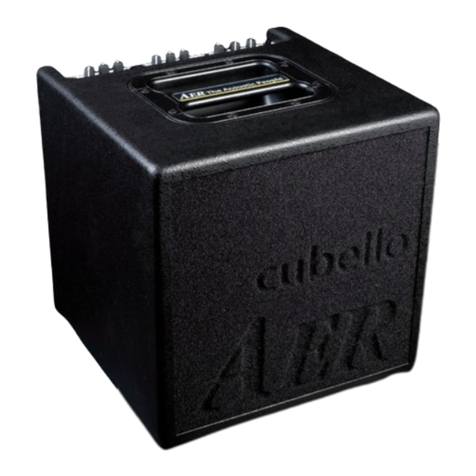
AER
AER Cubello User manual

AER
AER The Acoustic People Compact 604 User manual
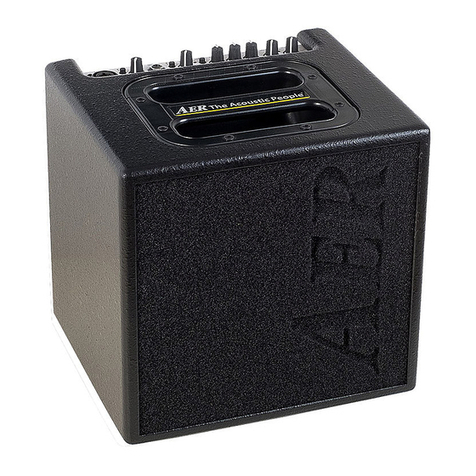
AER
AER Alpha User manual
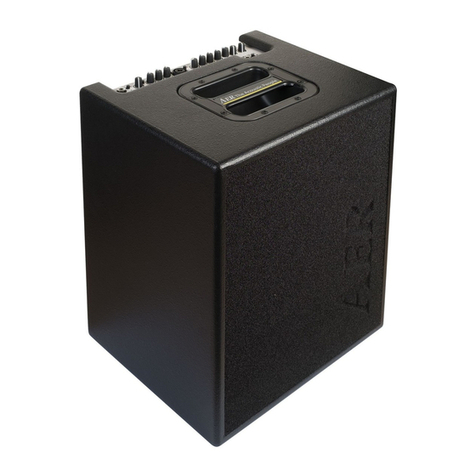
AER
AER MM 200 User manual
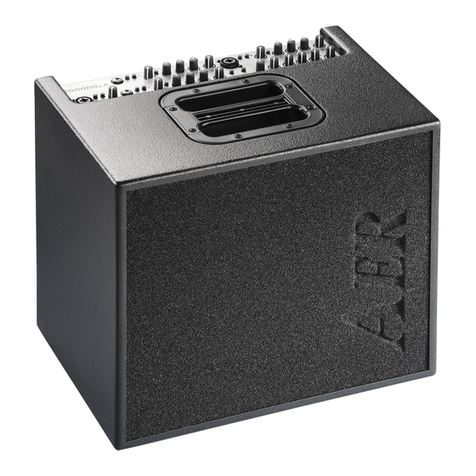
AER
AER Domino 2A User manual

AER
AER domino 3 User manual

AER
AER Compact Classic pro User manual
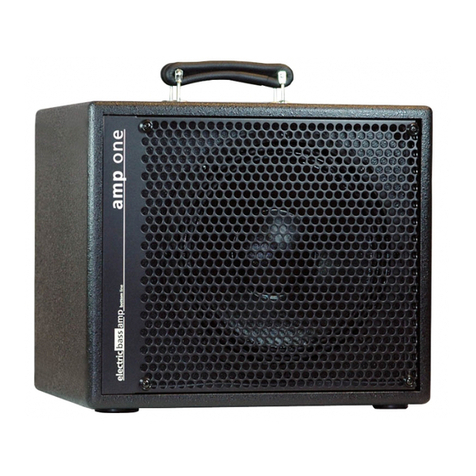
AER
AER amp one User manual
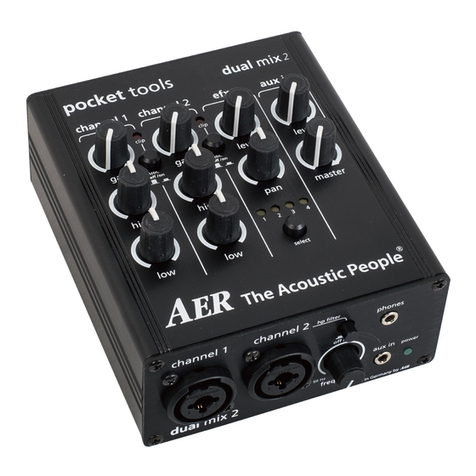
AER
AER Dual mix 2 User manual
